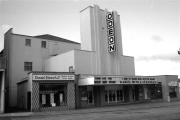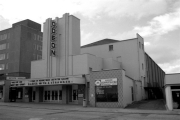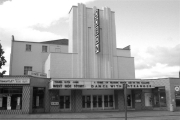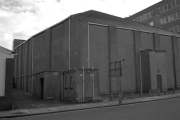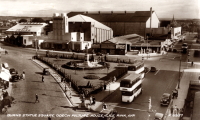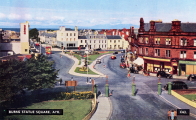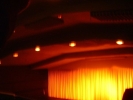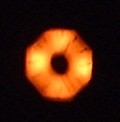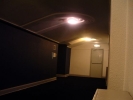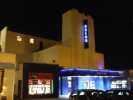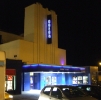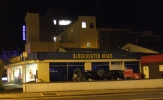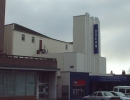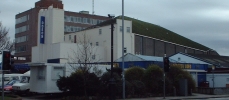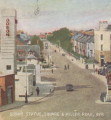Burns Statue Square

|
Official Odeon website: http://www.odeon.co.uk Despite alterations, this is an important building in the history of cinema in Scotland. The first true Odeon Theatre ever built in Scotland, where most of the chain’s cinemas were takeovers, it is also now the only one left. It makes an important contribution to the streetscape of Ayr, being one of the first buildings visible when exiting from Ayr railway station, its landmark tower giving a focus to Burns Statue Square. Photos below from 1985, courtesy of Paul Francis:
Click here for a gallery of interior photos from 1983, courtesy of Jim Duncan.
Odeon Cinemas in Scotland In the 1930s, the Odeon circuit had made its name by building a series of modern, well-appointed buildings, starting in the south, and then gradually expanding nationwide. However, it was struggling to gain a foothold in the highly lucrative, but extremely cut-throat Scottish cinema market. In sharp contrast, its great rival ABC had begun in Glasgow under the Scottish Cinemas and Variety Theatres (SCVT) name, and had a strong presence and purpose-built halls in most of the main Scottish towns and cities.
The main entrance block is two storeys high with the tower reaching up an additional storey to the height of the auditorium roof behind it. It is structured with three-dimensional projecting bands that sweep upward from above the canopy, and the side features sail over the parapet level where they terminate in an elegant curve backward. The central feature is less pronounced and terminates at the parapet. Originally, these bands were outlined in neon so that the cinema could be seen from afar, especially at night. There was also horizontal banding that outlined the canopy and at parapet level of the entrance block. Odeon neon name signs were hung vertically on the sides of the tower, and horizontally across the top, completing the composition. The vertical tower striations resemble Mather’s earlier Odeon in Portsmouth from 1936, but the Ayr cinema is far less busy and much more streamlined. The sweeping curve of the entrance area, together with the shop units that form wings on either side, and the way the tower is physically unconnected to the auditorium block appear to be unique features amongst Odeon cinema designs. The auditorium is set back from the foyer, and when viewed externally from the side, the roof can be seen to be sloping down towards the screen end. Unlike a traditional theatre, a building built purely for film did not require a fly tower, so there was no need to have a high roof at the screen end. This also had the benefit of reducing the volume of open space inside the building, thus reducing heating costs. This interesting roof construction was visible from inside, in the way the ceiling is segmented, and steps down towards the screen. The Scottish Odeons were done on a modest budget and at a modest scale compared to the finest and largest English Odeons. The designs for Hamilton and Motherwell seem to have suffered because of this; but at Ayr, possibly because it was the first one to open, or perhaps because there was a lot of competition from other fine cinemas in a seaside resort town, architect Thomas Braddock (see below) seems to have made much more of an effort to produce something individual and architecturally interesting. The tower has no structural purpose and is designed purely for show as an advertisement feature for the cinema to be seen from great distances. This is an excellent use of the building as its own sign - commercial architecture at its best. Despite the changes, the tower remains a dramatic landmark in the town and it would not take much to restore the exterior to its original gleaming state. Current Status The interior of the Odeon has been altered over the years, notably when the auditorium was split into three and later four separate screens. There are now two small screens in what was originally the rear stalls, one in the front stalls, and one in the balcony. (Originally with 1,732 seats, it was tripled in 1987; the fourth fourth screen was added in 1992.Current seating: 388 (former circle), 371 (former front stalls), 168 and 135 (both former rear stalls).). The interior was always quite plain however, so not a great deal has been lost. The building retains numerous subtle original features, including the handrails on the stairs to the balcony from the main foyer, balustrades in the balcony, curving plasterwork detailing on the balcony foyer ceiling, some light fixtures on the ceiling, and even, at the very back of the balcony, an internally illuminated octagonal Odeon circuit clock. While the foyer itself has been modernised over the years, it likely that original features such as cornicing and other plasterwork still survives above modern suspended ceilings. Except for the removal of the faience tiles from the entrance block and the resulting loss of detail, the exterior is very much as it originally built. The current blue tiles at ground level, while an unfortunate part of the current Odeon branding, would be easily replaceable. Special Interest During his lifetime, Oscar Deutsch built 140 cinemas throughout the UK. Atwell describes the instantly recognizable Odeon architecture as “among the best of any commercial buildings put up between the wars”. The Ayr cinema is the single surviving Odeon in Scotland, and was from the beginning one of only three ever to have ever been built here. Under the supervision of house architect Andrew Mather, it was designed by Thomas Braddock, who was also responsible for the circuit’s flagship cinema on Leicester Square (together with Harry Weedon and Andrew Mather). While Ayr’s structure has been somewhat altered over the years, it still definitely retains the unique Odeon look. It is of more than regional importance as the only remaining, purpose-built Scottish Odeon, despite the fact that the original design has been somewhat compromised over the years. The compromises – especially to the exterior – have the potential to be easily rectified. References Ayrshire & Arran: An Illustrated Architectural Guide (Close, RIAS, 1992) p. 19 Clyde Coast Picture Palaces (Peter, Stenlake, 2000), p. 44 – 47 Odeon Cinemas: Volume 1 (Eyles, BFI, 2002) p.156, 177-179, 250 Odeon Cinemas: Volume 2 (Eyles, BFI, 2005) p. 222
|
